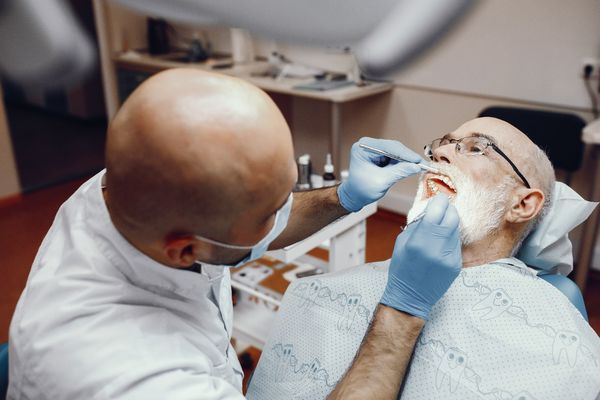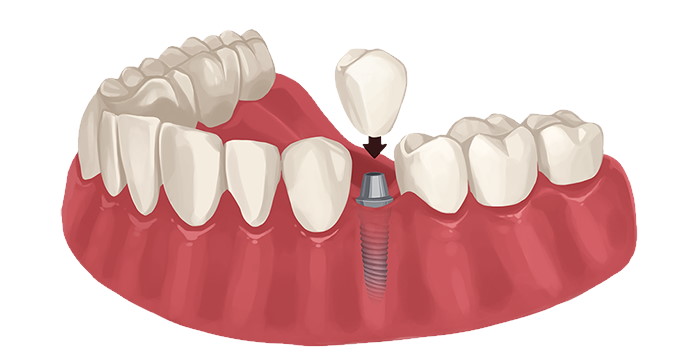Losing a tooth can be a grotesque experience for anyone. Generally, we lose a tooth due to the following reasons.

Gum disease
Periodontal disease is also called a Gum disease. This disease comes in the most common cause of tooth loss. Approximately 70% of teeth loss credit goes to this disease.
In most cases, it begins with bacteria and inflammation in the gums. After its progression, it begins to destroy the gum tissue. If you would not treat, it can also destruct the jawbone below the gums, consequently in no frame for the teeth.
Cavities
Cavities refer to the decay occurring on the tooth surface. In simple words, it is a hole in the teeth due to infection caused by bacteria, resulting in tooth decay. If left untreated, this hole can destruct the tooth center, that is, pulp. Consequently, you will most likely choose root canal treatment or tooth removal.
Physical injury or trauma
Particular injuries can lead to the loss of a tooth. These injuries can cause by accidents, specifically during sports. Hence, it is advisable to wear a mouthguard while playing sports. Car accidents fall, or other reason results in tooth loss. Hence, it is your liability to take care of your tooth. You can be assertive by taking precautions against the common cause of the accidents. You must not use your teeth on hard items or something which creates friction between the teeth. These are the following activities; removing caps, lids, tops, losing knots, tear off the bags, or cut threads. Save yourself from chewing these things too; nutshells, ice, popcorn kernels, and many other things like this.
Other diseases and risk factors
There are more diseases other than a periodontal disease that can lead to tooth loss. Keep in check these factors, if it would not take proper precaution, and can a gap or more in your smile.
- Diabetes
- Hypertension
- Arthritis
- Smoking
- Poor nutrition
How Dental Implants Work
Jaw bone starts to shrink due to the infection in the gums. It fills the gap between the teeth in traditional bridges but does not stimulate the jaw bone shrinking.
It can take the place of the tooth roots in dental implants, resulting in good jawbone structure.
The dental implants are made up of titanium, and after healing, it infuses with the jawbone. Hence, maintaining its shape. After the implants healed, connectors or abutments attached to them. It helps to secure the crown, bridge, or denture.
In general, dental implants may be right for you if you:
- One or more missing teeth
- Jaw bone reached its total growth
- To have physical eligibility for the bone graft
- Healthy oral tissues
- Not wanting to wears a denture
- The desire for speech improvement.
- The commitment of months to the process
- Quit smoking tobacco
Risks
Every surgery possesses some risk. In dental surgery, most chances are small and easily treatable. These are the risks:
- Infection at the implant site
- Injury to surrounding base, such as other teeth or blood vessels
- Damage of nerves that can cause pain, numbness, or itch in your natural teeth, gums, lips, or chin
- Sinus problem chances are moderate.
How you prepare
In the process of a dental implant, you have a team of specialists for the mouth, jaw, face, prosthodontist, and periodontist. Hence, it is a complicated procedure.
The whole process of the dental implant preparation includes the following:
- Comprehensive dental exam. In this step, an X-ray, image, and model of teeth and jaw are made.
- Review of your medical history. Make sure that you tell your medical conditions to your doctor. For example, if you have heart disease, let him know.
- Treatment plan. After following the above two steps, your doctor prepares your treatment plan per your teeth and jaw condition while considering other diseases.
Make sure that you know beforehand about the anesthesia to control your pain. In case of sedation, bring someone with you to take home.
What you can expect
- Dental implant surgery is an outpatient kind of surgery. Specific steps are required to complete this procedure. Healing is required between two phases. Here you can expect these things in this surgery:
- Injured tooth removal
Jawbone preparation, when required - Dental implant placement
- Bone growth and healing
- Abutment placement
- Artificial tooth placement
The whole process takes months. Hence, proper commitment and time are required for bone growth.
When bone grafting is required
If your jawbone is too soft, soft or the bone density is inadequate you may need bone grafting before you have dental implant surgery. It is because the chewing action power exerts pressure on your bone. Hence, the force is necessary for implant support.
Different materials can use in bone grafting such as, natural and synthetic.
Your condition determines the degree of jawbone surgery. It may take months for the proper growth of a jawbone.
Placing the dental implant
In the process of dental surgery, your surgeon reveals your bone by cutting. Then creates a hole for placing a metal post of the dental implant. It is placed deep in the bone for proper infusion of the metal post in the bone. At this time, you have a gap in your mouth. A bridge may be placed regarding the appearance.
Waiting for bone growth
After placing the metal implant post in your jawbone, osseointegration (oss-ee-oh-in-the-GRAY-shun) begins. In this process, the jawbone grows, resulting in uniting with the surface of the dental implant. This process requires many months. Hence, it helps to give a solid foundation for new synthetic teeth, a replica of roots for your natural teeth.
Placing the abutment
After completion of osseointegration, an addition to the above surgery requires placing the abutment. It is a part where all the pieces of crown subsequently attach. This surgery is a minor category and done in an outpatient setting. Local anesthesia was provided to the patient in this.
To place the abutment:
- Firstly, reopening your gum to reveal the dental implant by your oral surgeon.
- The abutment fixed to the dental implant
- The gum tissue is then sealed around, but not over, the abutment
In some cases, the abutment applies to the metal post of the dental implant. It is used when the surgeon implants the post. It also depicts that there is no need to take more surgical steps. It is because of the abutment just past the gumline. However, it is revealed when opening your mouth. It will remain that way till your dentist finishes the tooth prosthesis. According to some patients who do not like the appearance of the abutment, they chose to place the abutment in a separate procedure.
After the abutment is placed, your gums must heal for about two weeks before the attachment of an artificial tooth.
Choosing your new artificial teeth
When your gums are healed, there will be an impression of new teeth. These impressions use for forming the crown, which is a natural-looking artificial tooth. Your jawbone should be strong enough for giving support the tooth.
An artificial tooth can removable, fixed, or a combination of both:
- Removable. This type is the same as a traditional non-fixed denture and can be a semi or whole denture. It has synthetic white teeth enclosed by pink plastic gum. It rises on a metal frame that attaches to the implant abutment, and it fixes securely into place. In case of cleaning and repairing, it removes off conveniently.
- Permanent. In this type, an artificial toot fixes onto an individual implant abutment. The removal of the tooth for cleaning or even sleep is not an option. Generally, the crown attaches to its dental implant. However, implants have pronounced strength, and more than one teeth replacement may happen, only if they are bridged together.
After the procedure
Discomfort is inevitable in this procedure. These are the following discomfort that you may face during the first or later stages of the process.
- Swelling of your gums and face
- Bruising of your skin and gums
- Pain at the implant site
- Minor bleeding
You may need some medication regarding pain or antibiotics recommended by the doctor after the surgery. If any of the above discomforts exceeds more than normal, immediately contact your surgeon.
Following the ends of every stage of the surgery, the surgeon may recommend you to eat soft and nonstarchy food to eat. Conventionally, the stitches that your dental surgeon uses will dissolve by themself. In case of non-self- dissolving stitches, you may need to go to your dentist.
Results
Generally, dental implants are a success for the patient. However, in few cases, the complication may arise. These complications are unable to infusion of the jaw bone to the with the metal implant.
In case of infusion failure, the surgeon removed the implant and cleaned down the jawbone, and you can try again in about three months.
You can maintain and helps your surgery to get successful by following these things.
- Practice excellent oral hygiene. Practicing good oral hygiene can be one of the fundamental steps for saving your teeth. Artificial teeth also need to be clean.
- See your dentist regularly. Make sure that you pay a timely visit to your dentist for regular checkups.
- Avoid damaging habits. Ensures that you do not eat hard food like ice, popcorn kernels, smoking, and tooth staining products. Tooth staining products can be caffeine, tobacco, and other things like these.
Dental Implant Crowns to Replace Single Teeth
A dental implant uses to fill the gap of the single missing tooth. In the case of bridges, the crown supports both ends. In dental implants, the whole set provides supports to the jaw and teeth. Hence, it does not need to be surrounded by healthy teeth due to the crown attached to the implant. Additionally, the crown tooth is tailor-made so that it can blend easily with your natural teeth. You can also feel good about your appearance.
Dental Implants to Replace Multiple Teeth
In case of multiple teeth loss cases, the implants can attach to a denture. A bridge can replace one tooth or a few teeth in a row simultaneously. A fixed dental implant can remove the gap of 3-4 teeth with one to two dental implants without using the anchor appliance.
Dental implants stick to the semi dentures. Hence, it replaces multiple teeth. In the case of the complete dentures, it can replace the whole upper, lower, or both. Both dentures can be fixed or removable. There is a requirement of six implants for complete dentures. The attached implants can make the dentures completely stable, never slipping or wobbling out of place.


